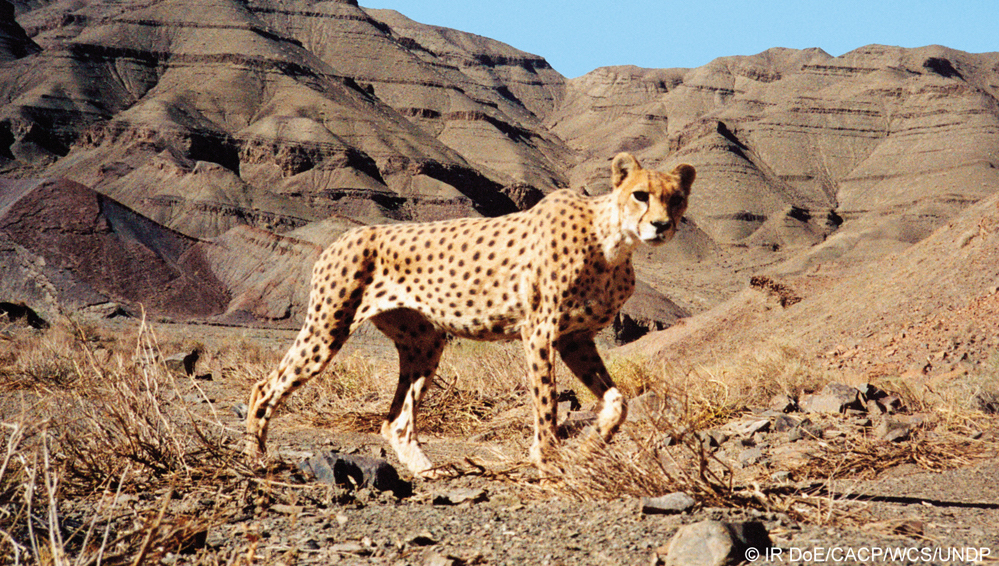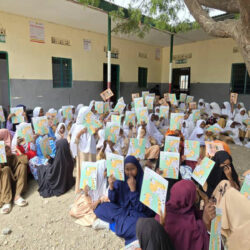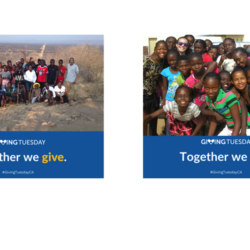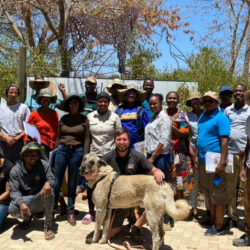Asiatic Cheetah
-

- by Jameson Bowman April 26, 2020

The African cheetah (Acinonyx jubatus) has three subspecies of the larger cheetah genome [1]. Ironically though and sadly, this misplaced belief may soon become true since its only remaining relative, the Asiatic cheetah or Acinonyx jubatus venaticus has less than 50 remaining in the wild.
A cheetah like species originated in North America and spread into Asia and Africa via the Bering Strait about 100,000 years ago, from there its ancestor spread across Asia and Africa.[2] Outwardly, all sub species have the tell-tale sand spotted coloured coats and black tear drop markings on their face. However, the Asiatic cheetah is slightly smaller and paler than its African cousin and are found in more arid and mountainous regions.[3] When exactly the African cheetah and Asiatic cheetah began to genetically diverge, and to what extent they are genetically different from each other is a highly debated topic.[4]
Some argue they began diverging 40,000 years ago, and therefore the subspecies are significantly different in both genetics and environmental adaptations. Others argue that the cheetah genome remains remarkably uniform due to a period of inbreeding caused by a population bottleneck the end of the last Ice Age 10,000 to 12,000 years ago.
The Asiatic cheetah once roamed from the Arabian Peninsula, the Caspian Region, Pakistan and through India, but now it only remains in Iran.[5] The Persian Epic “Shanameh” written around the first millennium CE refers to cheetahs as hunting pets, while the Ali Qapu palace in Isfahan contains depictions of cheetahs among its wall paintings from the 16th century. [6] Some scholars also believe that raising captive cheetahs originated in ancient Persia and not ancient Egypt as was commonly believed.[7]
The Asiatic Cheetah began declining broadly in the 1800s and was extinct throughout most of its range between 1940 and 1980.[8] In Iran, the cheetah remained in all the steppes and desert regions, and were believed to have a rising population until the 1970s.[9] Unfortunately the civil revolution of 1979, and the subsequent 8-year war with Iraq, had widespread negative consequences and the cheetah disappeared from almost all of the country by the 1990s.[10]
Since then, Iran has made a concerted effort to protect the cheetah with public awareness campaigns and very large fines for poaching, but the country’s resources are limited.[11] For a few years the United Nations Development Programme (UNDP) was able to bypass the trade embargos on Iran and support the conservation of the cheetah.[12] But over two years ago, this funding was stopped due to budget restrictions. The future does not look good.
Due to the international situation, we are unable to directly aid the Asiatic cheetah but there is a way to make a difference. For over 20 years, the Cheetah Conservation Fund (CCF), the global cheetah organization, has been at the forefront of cheetah conservation and genetic research. The plight of the Asiatic cheetah and the question of cheetah genetics is of paramount importance for the revitalization of global cheetah populations. Currently, in India there is a proposition to use African cheetahs from Southern Africa to replace the now extinct Asiatic cheetah. The debate is answered on the genetic issue and whether or not the subspecies are similar enough.[13] Dr. Laurie Marker, the founder and Executive Director of the CCF, has been actively involved in this debate over the past decade. (Recent press release)
To learn more about CCF’s research and conservation work and CCF’s state of the art genetic laboratories and Genome Research Bank (GRB) click here.
Join us to help us save the cheetah!
—————————————————————————————————————————————————-
[1] Charruau, P. et al. “Phylogeography, Genetic Structure and Population Divergence in Time of Cheetahs in Africa and Asia: Evidence for Long-Term Geographic Isolates.” In Molecular Biology (2011) 20, introduction.
[2] Valkenburgh, Blaire Van et al. “The Cheetah: Evolutionary History and Paleoecology.” Cheetahs Biology and Conservation. Ed. Marker, Laurie et al. Cambridge USE: Elsevier Inc. 2018, 50. Kolachalam, Namarta. “When One Big Cat Is Almost Like the Other.” In The Atlantic, September 16, 2019. https://www.theatlantic.com/science/archive/2019/09/can-india-bring-back-cheetah/598066; Durant, Sarah M. et al. “The Global Decline of Cheetah Acinonyx Jubatus and What it Means for Conservation.” In PNAS, January 17,2017 Vol. 114, No.3, 529.
[3] Farhadinia, Mohammad S. et al. “The Critically endangered Asiatic Cheetah Acinonyx Jubatus Venaticus in Iran: a review of recent distribution and Conservation Status.” In Biodivers Conserv (2017) 25: 1033.Kolachalam, Namarta. “When One Big Cat Is Almost Like the Other.” In The Atlantic, September 16, 2019. https://www.theatlantic.com/science/archive/2019/09/can-india-bring-back-cheetah/598066
[4] Charruau, P. et al. “Phylogeography, Genetic Structure and Population Divergence in Time of Cheetahs in Africa and Asia: Evidence for Long-Term Geographic Isolates.” In Molecular Biolgoy (2011) 20, 706-724.; Kolachalam, Namarta. “When One Big Cat Is Almost Like the Other.” In The Atlantic, September 16, 2019. https://www.theatlantic.com/science/archive/2019/09/can-india-bring-back-cheetah/598066; Farhadinia, Mohammad S. et al. “The Critically endangered Asiatic Cheetah Acinonyx Jubatus Venaticus in Iran: a review of recent distribution and Conservation Status.” In Biodivers Conserv (2017) 25:introuduction,; Boast, Lorraine K at al.”Cheetah Translocation and Reintroduction Programs: Past, Present, and Future.” Cheetahs Biology and Conservation. Ed. Marker, Laurie et al. Cambridge USE: Elsevier Inc. 2018, 282.; Prost, Stefan. “Conservation Genomic Analyses of African and Asiatic Cheetahs Acinonyx jubatus) Across Their Current and Historical Range.” In BioRxiv https://www.biorxiv.org/content/10.1101/2020.02.14.949081v
[5] Hunter, Luke. “Iran’s Endangered Cheetahs and Imperiled Conservationists (Commentary)” In Mongabay News, March 2019. https://news.mongabay.com/2019/03/irans-endangered-cheetahs-and-imperiled-conservationists-commentary.; Kolachalam, Namarta. “When One Big Cat Is Almost Like the Other.” In The Atlantic, September 16, 2019. https://www.theatlantic.com/science/archive/2019/09/can-india-bring-back-cheetah/598066; Extinction Watch: Amber Eyes, Dwindling Fast,” Economic Times. March 12 2020https://economictimes.indiatimes.com/news/environment/flora-fauna/extinction-watch-amber-eyes-dwindling-fast/articleshow/74601205.cms?utm_source=contentofinterest&utm_medium=text&utm_campaign=cppst
[6] Marker, Laurie et al. “A Brief History of Cheetah Conservation.” Cheetahs Biology and Conservation. Ed. Marker, Laurie et al. Cambridge USE: Elsevier Inc. 2018, 18.
[7] Extinction Watch: Amber Eyes, Dwindling Fast,” Economic Times. March 12 2020https://economictimes.indiatimes.com/news/environment/flora-fauna/extinction-watch-amber-eyes-dwindling-fast/articleshow/74601205.cms?utm_source=contentofinterest&utm_medium=text&utm_campaign=cppst
[8] Farhadinia, Mohammad S. et al. “The Critically endangered Asiatic Cheetah Acinonyx Jubatus Venaticus in Iran: a review of recent distribution and Conservation Status.” In Biodivers Conserv (2017) 25: 1040.
[9] Farhadinia, Mohammad S. et al. “The Critically endangered Asiatic Cheetah Acinonyx Jubatus Venaticus in Iran: a review of recent distribution and Conservation Status.” In Biodivers Conserv (2017) 25: 1040.
[10] Farhadinia, Mohammad S. et al. “The Critically endangered Asiatic Cheetah Acinonyx Jubatus Venaticus in Iran: a review of recent distribution and Conservation Status.” In Biodivers Conserv (2017) 25: 1040.
[11] “Asiatic Cheetahs on The Brink of Extinction with Only 50 Left Alive”, in The Guardian, Dec 16, 2017. https://www.theguardian.com/environment/2017/dec/16/asiatic-cheetah-brink-extinction-iran-un-funding; Hunter, Luke. “Iran’s Endangered Cheetahs and Imperiled Conservationists (Commentary)” In Mongabay News, March 2019. https://news.mongabay.com/2019/03/irans-endangered-cheetahs-and-imperiled-conservationists-commentary
[12] “Asiatic Cheetahs on The Brink of Extinction with Only 50 Left Alive”, in The Guardian, Dec 16, 2017. https://www.theguardian.com/environment/2017/dec/16/asiatic-cheetah-brink-extinction-iran-un-funding
[13] Kolachalam, Namarta. “When One Big Cat Is Almost Like the Other.” In The Atlantic, September 16, 2019. https://www.theatlantic.com/science/archive/2019/09/can-india-bring-back-cheetah/598066/
Related Reading
-
November 9, 2023
Giving Tuesday Canada 2023 – Supporting Namibian Youth



